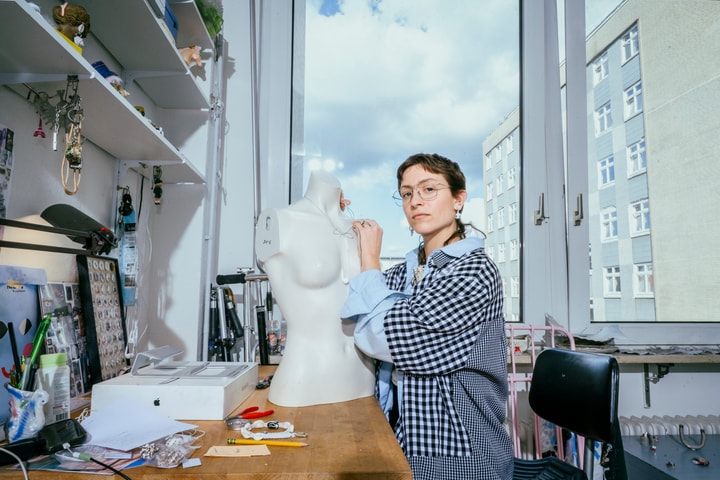This March marked thirty years since Lee Alexander McQueen's MA Graduate Collection debut show at Central St. Martins in London. Three decades have passed, but his vision is still relevant today. Take 2021 for example: Y2K low-rise pants frequented many model-off-duty looks, while kilts appeared in Virgil Abloh's Louis Vuitton SS21 show. One can't help but think of McQueen's bumster trousers and tartan designs.
In memory of the late designer, HYPEBEAST recently connected with John Matheson, whose Instagram account @mcqueen_vault chronicles all things McQueen, from magazine cut-outs to actual clothing.
For more than 26 years, Matheson’s archive has caught the attention of not only McQueen’s loyal fanbase but also family, friends, and past collaborators who were just as renowned for their unique fortes. Besides being bounded by fashion, Matheson and McQueen share a lot in common — both come from Scottish roots, grew up in more conservative times, and share an appreciation for culture beyond their own region. “This person gets it,” was Matheson’s first impression of McQueen after seeing the Fall/Winter 1996 collection “Dante.”
“It was storytelling at its finest. It made a political statement. It was rebellious,” Matheson continues on how McQueen struck a chord in him. “Lee McQueen really did not fit the system's norm, and he pushed back on it.”
Persecution was a persistent theme the late iconoclast explored. Most notoriously known was the FW95 “Highland Rape” collection, which featured bloodied models in disheveled clothing, and was revealed to be symbolic of the forced eviction of Scottish people by English landlords from the mid-18th to 19th centuries. Despite sparking controversy, the show launched his career and opened new doors, including his appointment as John Galliano’s successor at Givenchy.
Besides referencing historical narratives that hit home, films were another prominent influence on McQueen’s surreal and far-reaching ideas. “He was incredibly adept at being a filter for pop culture moments in cinema and art,” Matheson says. One remarkable theatrical portrayal was the SS04 “Deliverance” collection, which depicted a dance marathon inspired by Sydney Pollack’s They Shoot Horses, Don’t They?, a story set during the Great Depression depicting dancers who performed till exhaustion at the cost of little income. Alfred Hitchcock’s works were another regular source of inspiration, as seen in the SS95 “The Birds” collection and the FW05 “The Man Who Knew Too Much” collection. Mcqueen wasn’t the first and only fashion designer with a penchant for the past or pop culture, but as Matheson puts it, “he was clever enough to make them uniquely Mcqueen.”
Expanding on McQueen’s immersive storytelling, Matheson points out the late designer’s passion for world-building, for which “every element and every person that was brought in to collaborate on the collections were considered.” Many others have testified to McQueen’s boundary-pushing inclusivity: Fashion stylist Katy England previously recounted to dazed that ensuring models’ comfort and trust in the team’s vision at the SS99 “No. 13” show was prime for McQueen; Jewelry designer Shaun Leane also recalled to AnOther Magazine that McQueen offered him a boundless, creative world of freedom which brought out his desire to craft new, bold things.
Fast forward to 2022, the fashion landscape has changed and evolved — for better or worse. The rise of commercialism and homogenization of fashion have cultivated a different scene and the influential designers of the past like McQueen, such as Rei Kawakubo, Helmut Lang, Miuccia Prada, and John Galliano were, in Matheson’s words, “making culture bombs that are quite hard to imagine being repeated now.”
Nevertheless, some contemporary designers still convey clear and authentic messages encouraged by increasing diversity and cultural sensitivity within the industry. South African designer Thebe Magugu, for instance, stood out to Matheson this season with his SS22 “Genealogy” collection, inspired by his life with his family. “I think creating solely based on his lived experience is incredibly powerful, which is exactly what I like about McQueen.”
Now approaching his 27th year of collecting, Matheson still finds the search for curation fascinating and continues to build out the historical aspect of the late designer’s works. Coming off his recent collaboration with the Los Angeles County Museum of Art on the “Lee Alexander McQueen: Mind, Mythos, Muse'' exhibition, Matheson says, “it’s been one of my favorite jobs.” For this collaboration, Matheson took a different approach instead of the typical Mcqueen retrospective. “LACMA picked up on prominent themes in McQueen’s work, from environmentalism and the sourcing of fabrics to textile usage and embroideries from different cultures around the world. They’ve not only explored respectful veins of work but also approached them through the current cultural lens from a respectful yet subjective point of view to keep dialogues open.”
If you're based in Los Angeles, the “Lee Alexander McQueen: Mind, Mythos, Muse'' exhibition is open til October 9.
